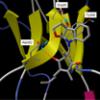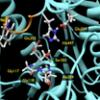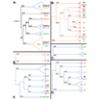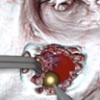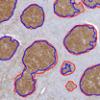A simulation created at the Ohio Supercomputer Center by Ohio State’s Chenglong Li, Ph.D., illustrates MDL-A (ball-and-stick) binding with a section of GP130 (yellow ribbon).
Press Releases
Primary tabs
Scientists are working to develop a new drug that will regenerate a critical enzyme in the human body that “ages” after a person is exposed to deadly chemical warfare agents.
Christopher Hadad, Ph.D., professor of chemistry at The Ohio State University (OSU), is leveraging Ohio Supercomputer Center (OSC) resources to help develop a more effective antidote to lethal chemicals called organophosphorus (OP) nerve agents.
Sensable announced that the South by Southwest (SxSW) Interactive conference in Austin, TX this week is spotlighting the use of advanced, touch-enabled medical simulation applications as a better way to train the next generation of surgeons worldwide – and Sensable’s role in furthering the trend.
An Ohio State University molecular biologist leveraged a supercomputer to help better define the family tree of a group of enzymes that have been implicated in a wide range of human diseases and are important targets for anti-cancer therapies.
Along with several OSU colleagues, Rebecca S. Lamb, Ph.D., an assistant professor of Molecular Genetics, recently analyzed the evolutionary history of the poly(ADP-ribose)polymerase (PARP) superfamily.
The Ohio Supercomputer Center (OSC) has signed a collaboration agreement with the Procter & Gamble Company, enabling the two to work together on modeling and simulation projects aimed at accelerating innovation collaboration between industry and academia. The collaboration is the first at the Ohio State University enacted under P&G’s master alliance agreement with Ohio colleges and universities.
Two surgeons from Central Ohio recently traveled to Nicaragua on a humanitarian mission to treat children with serious ear, nose and throat conditions. However, this year they brought along some help in the form of high-tech equipment designed to appeal to a generation that grew up playing video games – not to entertain the children, but to train the local doctors and medical students.
A research group led by Ohio State’s Metin Gurcan, Ph.D., has been leveraging Ohio Supercomputer Center resources to develop a computer-assisted diagnosis tool to improve grading of a common cancer.
Worried about her high fever and severe abdominal pain, a young couple rushed their baby daughter to the emergency department of Nationwide Children’s Hospital. Physicians there found a lump in her belly, and, after examining X-rays and blood work, confirmed the parents’ worst fear: their 18-month-old little girl had neuroblastoma, a rare pediatric cancer that involves the adrenal glands.
A new online publication unveiled this week, the Journal Of Computational Science Education (JOCSE), will publish peer-reviewed articles focusing on various aspects of teaching computational science – the application of computing, especially supercomputing, to the solution of complex scientific and engineering problems.
